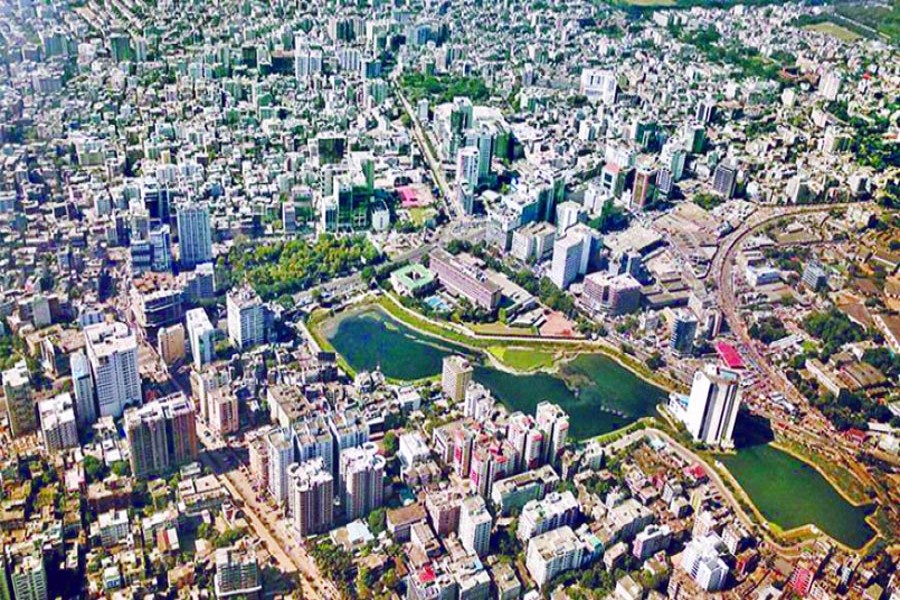
 In spite of Dhaka's hackneyed reputation of being an unwieldy city without planning, it can still boast of the phase when it passed its early days. That was nearly four hundred years ago, with the Mughal rulers in charge of the city's administration. Like many large cities today, it, too, grew on a dream, one that can materialise if a fledgling city banks on a plan. A Mughal-era network of canals dug across the city to keep it free of stagnant rain water and flooding had borne the first rough sketch of Dhaka's future town plan. It was Sir Patrick Geddes, the noted British architect and city planner of the early 20th century, who is credited with designing the first complete town plan for Dhaka. Assigned by the British administration, Geddes, an artist at heart, drew the plan stressing a sound environment for the future megacity.
In spite of Dhaka's hackneyed reputation of being an unwieldy city without planning, it can still boast of the phase when it passed its early days. That was nearly four hundred years ago, with the Mughal rulers in charge of the city's administration. Like many large cities today, it, too, grew on a dream, one that can materialise if a fledgling city banks on a plan. A Mughal-era network of canals dug across the city to keep it free of stagnant rain water and flooding had borne the first rough sketch of Dhaka's future town plan. It was Sir Patrick Geddes, the noted British architect and city planner of the early 20th century, who is credited with designing the first complete town plan for Dhaka. Assigned by the British administration, Geddes, an artist at heart, drew the plan stressing a sound environment for the future megacity.
Thanks to his concerns for Dhaka's environmental health and the overall well-being of its residents, the British architect shortlisted his priority tasks. Due to the issue's largely falling out of the public perception, the recovery and renovation of Dhaka's canals drew his attention first. He could ill afford to not homing in on it. Connected to the four rivers around Dhaka including the Buriganga, the canals of Dhaka had by then fallen on bad times. Except a handful of the large and operational ones, most of the smaller canals were gathering sludge and flood sediments. They needed immediate re-excavation. A creative architect with foresight, Patrick Geddes did not fail to notice the malady. In the following two centuries, the British colonial rulers had left the sub-continent after creating independent India and Pakistan, Dhaka being the part of the latter. The eastern wing of Pakistan later won political freedom under the name of Bangladesh. Scores of things changed in Dhaka, with the addition of newer features. Unfortunately, the bursts of change have kept eluding the canals in this 4 hundred-year-old capital city. The state of most of them continued to deteriorate, prompting them to become either dysfunctional or disappear altogether in an overpopulated and unmanageably growing megacity. This phase gained speed in the late 1970s.
It is the plight of Dhaka's present 58 canals and the city's ever-worsening water logging which makes the claim of the capital's perceived growth on a planning sound absurd. Of late, water logging has begun appearing to be undoing the humble mileage Dhaka has been able to achieve after the country's independence in 1971. The status of Dhaka as capital of an independent country has brought along with it a number of great opportunities for the city's modern uplift. The urban authorities have tried their best to make use of them. But the agents of paranoia, fuzzy policy making and bureaucratic hubris also lurked in the development mechanism. Wobbly political will added to the pervasive dysfunction of the otherwise strong impetus for putting fresh ideas in place. All this has left their deleterious impact on the physical features of Dhaka. Thus the scourge of water logging has degraded to such an extent that the spells of even normal monsoon showers now result in a submerged city. The indescribable woes that befall Dhaka in monsoon after prolonged rains underscore the need for urgent, effective measures. It's time we bade farewell to the days of ad hoc remedies. This blighted city has had more than its share of stagnant rain water. Coming to such a pass, it can be saved only by the relevant government agencies swinging into action. They can ill afford to dilly-dally on this critical imperative. After the two-day downpour on October 20, 21 urban experts resorted to the repeatedly stressed solution: recovery of the city's vanished canals. According to many, putting into operation mere 26 out of Dhaka's 58 fully or partly choked canals will see a remarkable decline in the intensity of the city's water logging.
Dhaka's plight and the great prospects were discussed at an international conference in the city held last July. It was organised by the World Bank with the participation of city planners, urban experts and administrators from Bangladesh and abroad. The conference was titled Development Options for Dhaka Towards 2035.
With the megacity witnessing veritably a continuous plunge in terms of urbanisation, its problems appeared to have overshot water logging and the related public woes. Dhaka is now considered one of the large cities in the world crippled by dreadful traffic gridlocks. Traffic jams and tailbacks continue to chip away at all its potential --- be they on economic or social level. As part of the rituals of urban governance, plans and master plans have been in place since the late 1950s. The first long-term plan for Dhaka was launched in 1959 on a 20-year timeframe from 1960 to 1980. Its progress has been found tolerably satisfactory up to the early 1970s. Later, the massive-scale plans for the maddeningly growing capital city joined the national bandwagon of ending up in setting impractical goals coupled with rhetoric. Meanwhile, the population of Dhaka kept galloping with pressure mounting on every urban infrastructure. By the 1990s, traffic chaos emerged as a highly menacing scourge. Alongside the long-drawn-out drafting and revisions of the Dhaka detailed area plan (DAP), several traffic movement plans were undertaken. A lot of thoughts, efforts and financial fillips were put into the Strategic Transport Plan (STP) of 2005. In the same way, Dhaka Urban Study was proposed by Japan International Cooperation Agency (JICA) in 2010. These mega plans accommodate holistic and perspective strategies for an all-out development of the urban Dhaka. The prospects latent in these grand projects do make Dhaka's helpless people feel upbeat.
With time, energy, resources and productivity going to waste since long, the gridlocked city people's desperation for a way out cannot be lost on the authorities. In keeping with the grim state of Dhaka's urban mess, the expert recommendation at the July Dhaka conference for expanding the metropolis to the east has been received by the participants with due seriousness. The speakers cautioned against delays in this regard, urging immediate action. What they dreaded was yet another spate of unplanned urbanisation, this time on the city's eastern fringe. It has already started raising its neck. The ambitious schemes on mass rapid transit for Dhaka and the surrounding areas under the Dhaka Transport Coordination Authority (DTCA) have lent considerable weight to the plans in the making. The recently launched work on the elevated metro rail project, a component of the multi-segment Mass Rapid Transit facility, and the in-city flyovers, both opened and being constructed, can reasonably be viewed as harbingers of a radically transformed Dhaka.
The July Dhaka international conference turned out to be significant on a number of counts. In terms of the breadth of agenda in discussion, it has proved a unique and extensive one. It was at this meet that the local urban planners and administrative functionaries were able to learn about the first-hand experience of transformation of a few cities. Dhaka was fortunate enough to hold such a conference with wide participation. It was a great experience to hear from Sheila Dixit, former Chief Minister of Delhi, how the Indian capital could be transformed from a haphazardly growing, squalid and gridlock-choked city into one freed of these ills. The former Delhi CM stressed two imperatives for a city's healthy growth --- Stern city governance and enough power for the local government. The unique experience was shared by the planner of the new Shanghai in China. As the architect has spelt out, the high-end Chinese metropolis of 2017 was once like the Dhaka of the 1990s. While telling about the urban Shanghai's radical change, the planner referred to pragmatic and effective financing of the grand project.
Of late, Dhaka became a metonymy for unplanned, unwieldy cities. Few of its residents can deny it. As many experts observe, in spite of the lost opportunities, Dhaka still has escape routes that remain woefully untapped. They include the retrieval of the lost canals and resumption of their connections to the four rivers surrounding the capital to address water logging. In bringing discipline to its chaotic traffic, the largely underutilised circular waterway can play a great role. As an idea it's highly innovative and revolutionary. Few big cities are blessed with as many as four rivers like Dhaka. Due perhaps to gridlock-free roads in the past, the plan may have eluded the Mughal and British rulers.
Dhaka cannot be retrofitted as it has already got stuck in its centuries-old architectural frame. The structure has long started decaying. Given this unique turn of the urban make-up of Dhaka, adding yet fresh stretches to its present cityscape, i.e. expansion, can come up with a solution. The idea connotes an extensive remodelling.
The writer is Associate Editor of The Financial Express.
© 2024 - All Rights with The Financial Express
